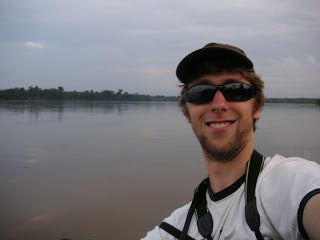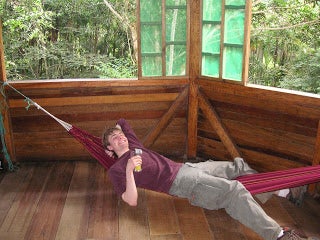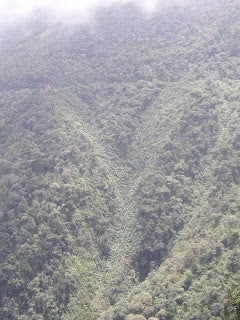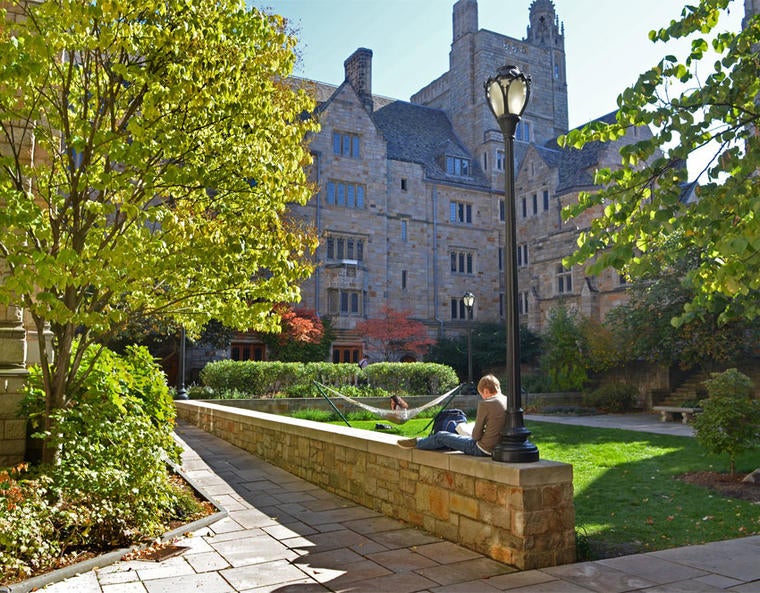
Since taking office, two of University President Richard C. Levin’s goals have been to expand funding and research opportunities for the sciences and to increase the number of international opportunities and connections for undergraduates. In a stroke of brilliance, the two were combined to create my spring break of my sophomore year, where my ornithology lab got full funding to go on a birding trip in Ecuador, applying everything we had learned about behavior and taxonomy in the classroom to actual field study.
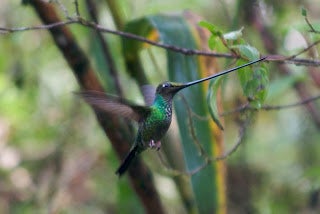
One of my favorite birds from the trip, ensifera ensifera, the sword-billed hummingbird.
This post may be a long one, because I have a lot of cool bird pictures to share, but it’s worth it!

The trip was a pretty small group, consisting of the 12 people in the lab, the grad student TA, our professor, and his birding colleague, the director of inverterbrate collections at the Peabody Museum of natural sciences. I didn’t know most of them too well before the trip, but now we’re all really close. The professor is no longer “Professor Prum”- just Rick.

Our total for the two week trip ran to 455 unique bird species identified- for someone like me with no birding experience, it was an intense crash course. We saw birds that still hold a legendary status among the birdwatching community, like the Tanager Finch, an unclassified bird that hasn’t been spotted in 50 years. Above is the incredibly rare Giant Antpitta- this individual was known as Maria, and with the help of some native guides we got within feet of her.

I had always imagined birdwatching as something that bored old people did as a hobby, until I tried it myself. Serious birders are perfectly happy to get up before the crack of dawn for the early birds, hike all day in search of diurnal birds, stay out late for the nocturnal ones, and get up the next morning, driven to do it all again. My professor, the most intense birdwatcher of all, is honestly an inspiration- if I can ever find that degree of passion for anything that could compare to what he holds for birds, I will count myself a successful man.
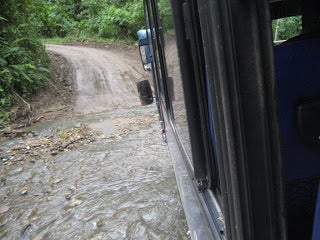
As we drove up, down, over, across, and through the Andes in the nonstop quest for birds, we encountered some pretty epic conditions. We dealt with landslides, roads washing out beneath rivers, and even fallen boulders blocking the road. In a rampant display of manliness, a few other guys and I pushed the boulders off the road. Rarely has driving been such an adventure.
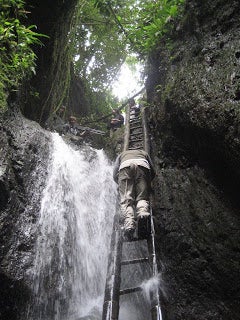
On our second day of exploring the western slopes of the Andes around Mindo, we spelunked an oilbird cave. It was literally a crevasse torn deep into the earth, and we had to traverse slime-covered ladders and waterfalls in our descent.
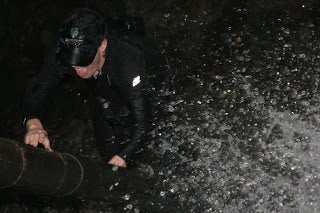
The ladder actually went right through the waterfall- we got soaked!

But for all the effort, we found nesting steatornithidae, one of the most ecologically unique birds out there. They use echolocation to navigate within the caves at night, and eat only avocado and palm oil. In fact, they’re so oily that Quichoa natives in the area traditionally ground up the birds for cooking oil and candle making.

I have a long history of climbing statues that I’m probably not supposed to- so when I found this oversized statue of the Andean Cock-of-the-Rock, I couldn’t resist climbing to the top. We all had to notice, though, that the coloration here isn’t true to the real bird. I was absolutely ruined when I tried to buy souvenirs, because most of the bird-themed trinkets weren’t real species and I couldn’t bear to buy any that weren’t biologically accurate. :p
On our first trek to the East of the Andes, we hopped a half hour flight from Quito to Coca. From there, we boated along the Rio Napo, one of the major tributaries to the Amazon. I played the computer game Amazon Trail as a little kid, but never imagined I’d actually be there- it still blows my mind.
We got into still smaller canoes for the last leg of the river to Sani Lodge, part of the reservation for the Quichoa natives who now run eco-tourism ventures. I spent this boat ride with just the guides, and my professor on the one boat- my bird count went WAY up for spending some time with Rick, and I learned a ton about the incredible research he’s now doing with soft matter and light defraction in the structural colors of feathers.

The view from outside Sani Lodge, along the river.
The latter half of the trip was mostly in the Amazon lowland basin- here we started climbing an observation tower built into an enormous queypac tree. My camera couldn’t begin to handle the scale, but the tree went over 150 feet straight up! I tried my hardest to ignore the presence of a termite nest living at the top.

Look closely- that’s not just a dead stump. It’s a potoo! This family of birds has the adaptation of looking and behaving exactly like a dead tree (AKA not moving all day) to avoid predation.
The rainforest definitely isn’t the stereotypical college spring break, but we still stayed at some pretty swanky resorts in between long bouts of birdwatching- all on Yale’s dime. Relaxing in the tropics is great- we even went swimming in a cayman-infested lagoon near this lodge, and somehow lived to tell the tale.

Again, not the typical spring break. Instead of wet t-shirt contests, we had wet poncho contests when we got caught in tropical storms.
Even though the focus of the trip was on birds, traveling with such brilliant minds I picked up a lot about rainforest biology of all kinds. Here, we took a quick break from searching for Pointtail Palmcreepers for Rick to explain how the strangler fig had grown up around and finally dragged this other tree down.
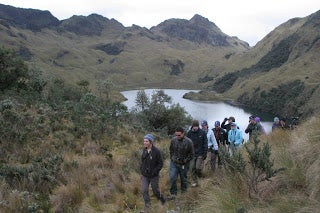
Ecuador is about the size of Connecticut, but for its size its one of the most biodiverse places in the world. You can get a sense of it by the huge variety of terrains here, from mountainous cloud forests to lowland rainforests to barren rocky lakes far from civilization, all in search of more birds.
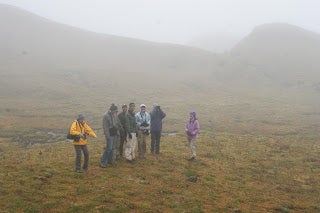
I couldn’t believe that there’d still be birds on the highest peaks of the Andes, but we braved the elements in search of those rare ducks and hummingbirds crazy enough to make the moss and fungus covered summits their home.
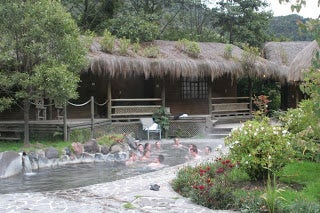
Our resort up in the Andean slopes around Papallachta had hot springs heated by volcanoes. Let me tell you, this was HEAVEN. This makes up for all the sweat and grime and bugbites you could possibly accumulate in two weeks of trekking the wild.
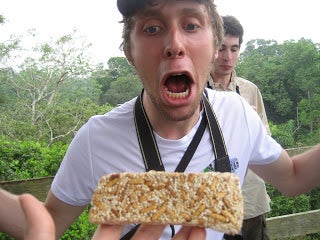
This is just a silly picture I had to share- some of the snack bars we ate looked exactly like packed bird seed. Here, I do my best impression of a parrot swooping in.
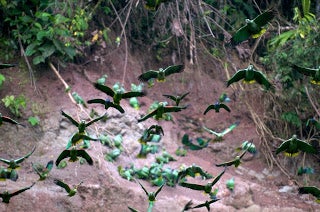
Speaking of parrots swooping, we visited a parrot lick, which is a mine into a hillside naturally formed by foraging parrots. They eat a lot of seeds, so to deal with the all the natural plant toxins that build up in their diet, they eat clay right out of the ground that neutralizes the poisons.

I like to imagine the mealy amazon parrots here are telling themselves NOM NOM NOM as they chew up this rock.
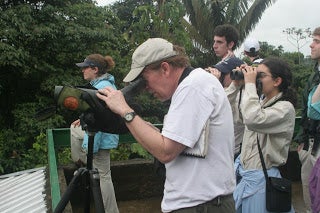
Look at him go- Rick is always on the lookout, and it’s infectious. Back in New Haven now, I can’t stop identifying the latin names and behaviors of the birds I see.
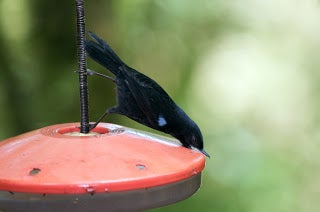
We discussed a lot about different behaviors and adaptations to ecological niches- this glossy tanager actually puts his entire lower jaw inside the feeder intended for hovering hummingbirds.
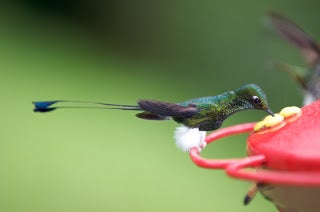
And for your viewing pleasure, a few more hummingbirds- we saw 56 different species in Ecuador. You could actually consider this a little low considering there were more than 150 in the country to be found. Above is the male racquet-tail.
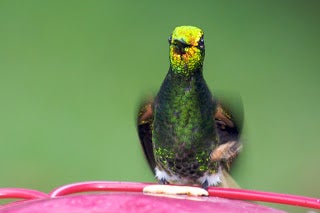
A bandy winged puffleg: some birds have very silly sounding names.
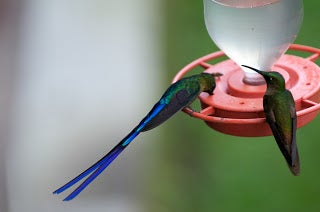
A violet trainbearer (left) and the pteryian bronzewing (right).

The sapphirewing. Even with the high end photo equipment brought for the trip, hummingbirds are so hard to capture on film. They never stop moving!
Early in the trip, when I looked across the slopes and saw the shape of an enormous Y formed by the growth patterns of trees, I knew it was a good omen. This was the adventure of a lifetime, exploring such a remote and wild part of the world while learning an absurd amount of ornithology. To the unitiated, I probably seem a little bizarre now for the kind of glee with which I’ll point out any bird on the street, but I love it.
If you like birds, or biology, or getting funding to do research abroad, definitely go to the Online Course Information and check out EEB 272/273, or MCDB 230, another class that gets to do research in the rainforest.
